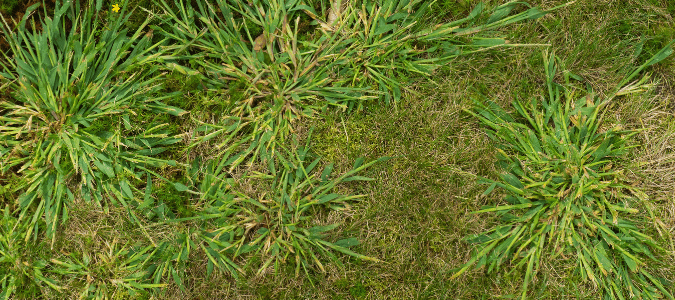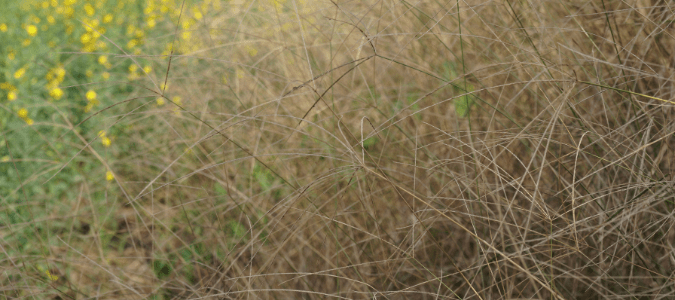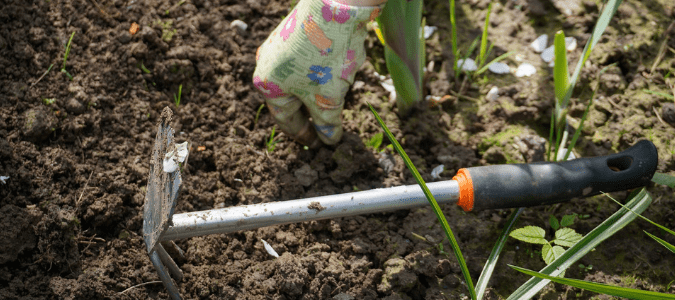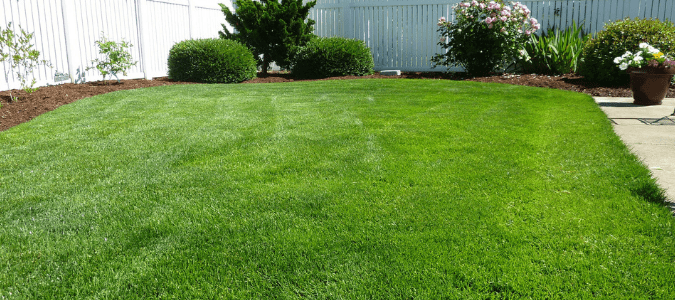
The condition of your yard is a large part of your property’s overall curb appeal. Because of this, homeowners can spend significant amounts of valuable free time making sure plants are watered, the grass is mowed and everything is healthy. Despite your best efforts, many of us have to deal with weeds. If you are trying to troubleshoot a weed problem, you might come across information which leads you to ask yourself: What is crabgrass?
Crabgrass is one of the most common weeds which can grow in residential areas, as well as popping up in gardens, orchards and vineyards. Also sometimes called summer grass, watergrass and crowfoot grass, crabgrass stems extend out from a central cluster in a way which resembles crab legs. Along with other common weeds, crabgrass was inadvertently introduced from Eurasia, and can become very difficult to remove. Crabgrass is an annual, meaning that the plant germinates, produces seeds and dies in a year’s time.
In this post, we’ll learn more about this scourge of residential lawns so that you are equipped with the information you need to address this common yard issue and prevent future weed growth.

Why Is Crabgrass Bad?
In addition to affecting the appearance of your outdoor spaces, weeds weaken your lawn by taking away light, water, nutrients and space. Weeds often have an opportunity to become established when your lawn is not completely healthy, such as when your plants are experiencing stress due to drought, pest infestations or disease. Even improper lawn maintenance can make your yard vulnerable to this common lawn problem. Recurring weed problems are often a sign of some other lawn condition that may require a professional’s help to properly assess so that you can take the most appropriate next steps.
Crabgrass tends to germinate when many of us aren’t spending much time in our yards: when the temperature of your soil gets between 50 and 60 degrees Fahrenheit. Your location, along with rainfall and temperature, can trigger germination. In warmer states, the soil reaches a consistent 55 degrees for more than three days in a row in the late winter.
One reason that homeowners have a hard time controlling crabgrass is that this plant resembles other common lawn species. Turf types that are frequently mistaken for crabgrass include Dallisgrass, Bermuda grass, tall fescue and quackgrass.
You can tell Dallisgrass and Bermuda grass (also known as wire grass) from crabgrass because of their reproductive structures, which allows crabgrass to spread more quickly in your garden or lawn. While Dallisgrass has thick, short rhizomes that are underground, Bermuda grass has thin underground rhizomes and stems called stolons that are aboveground. Crabgrass lacks stolons or rhizomes and spreads primarily through seed.
Since plant anatomy is beyond the grasp of most homeowners, you should know that the flowering stems of Bermuda grass and crabgrass are slightly different. If branches at the end of the stem sprout from the same point, you have Bermuda grass. If the branches originate from spots less than a quarter-inch away from each other, you probably have crabgrass. While crabgrass found in most lawns grows in a cluster, Bermuda grass extends more like a vine along the surface of your lawn.
Like crabgrass, tall fescue grows in clumps. One distinct characteristic is that fescue has wide, rather than narrow, leaf blades. Patches of tall fescue are circular and stick out when sprouting. Tall fescue is a cool-season perennial grass, thriving during spring and fall while growing more slowly in warmer seasons. Most patches of tall fescue have dark green leaves with a glossy lower surface.
Quackgrass and crabgrass can both grow rapidly under the right conditions. Most homeowners confuse the two species because of their coarse leaf blades. In addition, young quackgrass plants appear hairy, making them resemble large crabgrass. Quackgrass is a cool-season perennial, however, with finger-like projections at the case of the leaf. A careful inspection of the blades of your grass can help spot these slight differences.
Apart from resembling other common lawn species, crabgrass is a headache to homeowners because it can sneak up just about anywhere you have bare soil and sunlight. You might find this opportunistic weed in the most unlikely spaces, like along the edges of a driveway or in the cracks of a sidewalk.

Types Of Crabgrass
The two most common types of crabgrass in North America are smooth crabgrass and hairy crabgrass.
Hairy Crabgrass (D. sanguinalis)
Also known as large crabgrass, hairy crabgrass (shown above) can grow as tall as two feet. The leaves of this type of weed are hairy. While smooth crabgrass can come back after close mowing, hairy crabgrass may not, making this type less common in residential lawns.
Smooth Crabgrass (Digitaria ischaemum)
Smooth crabgrass is a low-growing annual that usually dies at the first frost and can grow to as high as 6 inches tall if unmowed. As its name suggests, the leaves of this weed are smooth, although you may notice hairs on the underside of the leaf. The leaf blade is pointed and can grow up to 5 inches long. The blade is between one-quarter and one-third of an inch wide. The plant can produce seeds even if it is cut down to one-quarter of an inch. The seedlings’ light green color can stand out against the rest of your grass. As the plant matures, the leaves become a darker green color. Smooth crabgrass tends to appear in large clumps in your lawn.

How To Remove Crabgrass: Weed Management Tips
Once crabgrass and other grassy weeds emerge in May and June, applications of post-emergent herbicides can control these invaders. You can sometimes spot seedlings by surveying bare spots in your yard and along sidewalks if you want to try to perform hand pulling. Post-emergent herbicides are most effective when weeds are still growing and not fully mature. If you follow the instructions on the label, selective post-emergence herbicides will target crabgrass and other annual weeds without damaging your turf.
To be effective, these treatments must be absorbed over the course of 24 to 48 hours after application, so avoid mowing your lawn immediately after adding herbicides. If you elect to use granular post-emergence herbicides, perform your application in the morning, so the herbicide is more readily absorbed. An experienced lawn professional can advise you on which products would work best in your yard and can manage your weed control efforts.

How To Prevent Crabgrass From Becoming Established
The best defense against a crabgrass invasion is maintaining a healthy lawn. A few things that homeowners can to do to maintain lush, vibrant grass is to mow at the appropriate height for your turf type, have the grass species in your yard that is well-suited for your surroundings, overseed to keep a dense ground cover, fertilize as and when needed and water regularly.
Mowing To The Right Height
Crabgrass has a harder time germinating and becoming established if you mow at a height that is appropriate for the type of grass in your outdoor areas. If you do mow grass that is infested with weeds, you’ll want to wash off your blade afterward so that you don’t accidentally move seeds to another location in your yard.
Here are some general guidelines for optimal grass height for common lawn species:
- Bermuda grass: 1 to 2 inches
- Buffalo grass: 2 1/2 to 3 inches
- Centipede grass: 1 1/2 to 2 inches
- Kentucky bluegrass: 1 1/2 to 2 1/2 inches
- Rye grass: 1 1/2 to 2 inches (up to 2 1/2 inches if a perennial variety)
- St. Augustine: 2 1/2 to to 3 inches
- Tall fescue: 2 to 3 inches
- Zoysia: 1/2 to 2 inches
Choosing The Right Grass Type
You’ll not only want to consider which types of grass grow best in your area, but also your requirements. Do you need a lawn that can withstand the activity of dogs and children? Or do you have towering trees and lots of shade? You’ll also want to consider how much time you want to spend on lawn maintenance.
Depending on how cold your winter gets, warm-season grasses may become straw-colored in the winter, when they may remain dormant. A few types may suit your needs include:
- Bermuda grass, which does best in full sunlight and can tolerate traffic and drought.
- Buffalo grass, a species that thrives in areas which receive less than 25 inches of rain each year. In places that receive more rain, weeds can develop. Otherwise, this tends to be low maintenance grass type when in full sun.
- Centipede grass, a slow growing turf type that does not do well in drought conditions and has a low traffic tolerance, but thrives in full sun to light shade. This low-maintenance species doesn’t need much mowing or fertilizer.
- St. Augustine, a grass type that can tolerate shade but suffers in extreme winter temperatures. Not tolerant of high traffic, this species doesn’t do as well in drought as Bermuda grass or Zoysia.
- Zoysia grass, a species which can tolerate drought but may turn brown. Not as shade tolerant as St. Augustine, Zoysia does best with moderate traffic. Some varieties require more maintenance than others.
Cool season grasses don’t do as well in hot areas with high humidity. These grass types do best in spring and fall:
- Kentucky bluegrass, which does need extra watering, and can be vulnerable to disease in humid areas. This species is adapted for lawns in northern states.
- Rye grass, that can become a permanent ground cover if the perennial type is watered. Annual rye grasses can give your yard a colorful boost. This grass can also prevent erosion in bare spots on a temporary basis until a lawn can become more established.
- Tall fescue, a species which does not do well in yards that experience heavy traffic. Lawns with this type of grass will need more watering during the summer months. Tall fescue can tolerate some shade and drought.
- Texas blue grass, which looks like Kentucky blue grass but stays green year round in hot and sunny areas. This grass type does best in yards with little traffic and needs less water than tall fescue.
Fertilizing During The Growth Season
Giving your grass an extra boost when it’s growing can discourage weed development. An experienced lawn professional can advise you on the best time to add amendments to your lawn that are low in phosphorus and high in nitrogen and potassium. Soil tests can help you determine how much and which nutrients should be applied.
Proper Watering
How often and how much you water your lawn can be a factor in your weed growth. If you water too much, or too often and not enough, your soil will be more vulnerable to a crabgrass invasion. Watering a lawn at night is one mistake some homeowners make who see weeds growing in the summer months. You’ll often notice that crabgrass develops in areas without grass, near sidewalks where the ground tends to be warmed and near sprinkler heads where grass is usually cut shorter.
Mulching To Discourage Growth
By blocking the sunlight that crabgrass needs to germinate and become established, this weed cannot take over your yard. Mulch can perform this function when it is applied to beds and around trees. You may choose a mulch made from wood or compost, or add mulch on top of landscape fabrics. If you select a mulch that has smaller pieces, 2 to 3 inches on top of your landscape should be adequate.
Keep in mind that organic mulch can actually provide an ideal environment for the growth of weeds. You can break up seedlings with a rake or hand pull plants. A hand-held burner is not recommended, as you may accidentally set fire to nearby materials.
If you get lots of sun in your yard, you might want to use the sun’s power to keep weeds away. If you cover problem areas with plastic sheeting, you can increase temperatures enough so that the weeds cannot grow. Solarization requires no chemicals and works best during the hottest months of the year. Generally, between four to six weeks is adequate to get the temperature high enough to be effective, although two months may be required to neutralize summer weeds.
Applying Preventative Herbicides
Preventative measures tend to be more effective to serve as a barrier to control crabgrass and have less of an impact on your turfgrass than post-emergent treatments. One of the challenges with weed control is that you need to know which type of invader you are dealing with to craft an appropriate treatment strategy. While many weeds look the same, crabgrass is a grassy weed, characterized by long, thin leaves and parallel veins that extend the entire length of the leaf. Broadleaf weeds, on the other hand, have branching veins with wider leaves.
Since crabgrass seeds can stay viable in your soil for three years, control efforts should focus on preventing the weed from setting seed. Applying pre-emergents are especially important in yards that have had crabgrass infestations in the past. Fall is the time when crabgrass and other summer weeds produce large numbers of seeds. Winter weeds, on the other hand, set seed at the end of spring and the beginning of summer.
If you apply pre-emergent weed control products before crabgrass germinates or post-emergent products after germination, you can control this weed in your turf and your beds. When it comes to weed control, knowing when to use an herbicide is almost as important as which treatment solution you use. Usually, the best time period for these types of treatments is between March 15th and April 1st. You’ll want to be careful about using these products in vegetable gardens.
As with any type of product, read the directions carefully, choose a treatment that is designed for your grass type and follow all the instructions. There are a host of factors that dictate how effective your efforts will be, including the timing of your treatments, turf preparation, coverage, the amount you apply, the impact of rain showers immediately after application and follow-up treatments. Your best bet for this preventative weed control is to have a trusted lawn company treat your lawn when, where and how your landscape needs it.
ABC Can Keep Your Yard Weed-Free
Weeds are stubborn plants which can quickly take over your outdoor areas and take away from all the time and effort you put into maintaining a beautiful landscape. A preventative approach is most effective to control crabgrass and other summer annual weeds. ABC Home & Commercial Services is a locally-owned business that has been helping Texas homeowners keep their yards looking great for generations. Our lawn specialists can determine the type of weeds growing on your lawn and implement an effective treatment plan to keep these invaders from becoming established. Our specialists know just when and how to mow different grass types, when to fertilize new grass and how to protect your turf from extreme temperatures, pest invasions and disease. With ABC’s help, you can keep your grass and plants healthy and thriving year-round.
